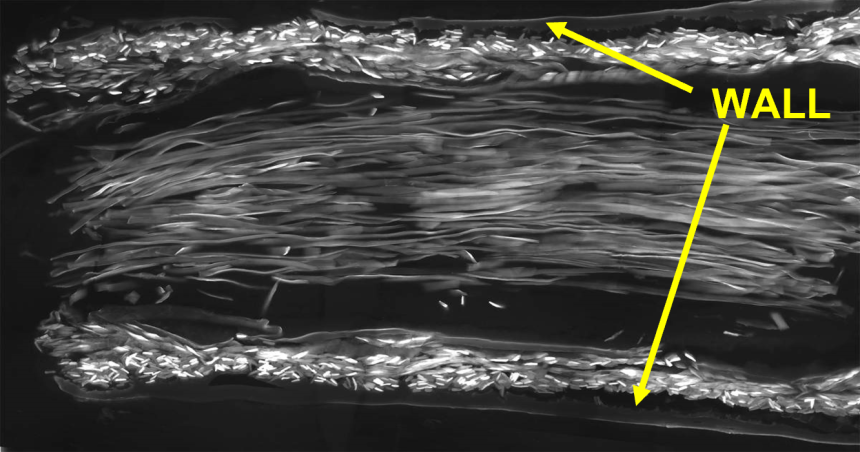Researchers from the University of Oxford and MedUni Vienna have demonstrated that tubes combining silk from silkworms and spiders are highly effective in repairing severed nerves. The results, published today in the journal Advanced Healthcare Materials, could significantly advance therapeutic options to treat nerve injuries.

Scanning electron microscope image of a longitudinal section through a silk conduit containing nerve-guiding luminal silk fibres. Image credit: Newrotex Ltd
Nerve guides made of natural or synthetic materials are an important surgical tool for nerve repair. These tubes are sutured to both ends of an injured nerve to guide the growth of nerve fibers and cells across the gap. However, these can only be used to bridge very small distances.
It was thought that a key reason for this limitation was the lack of an internal framework to act as a “handrail” along which the regenerating tissue can orient itself and grow.
In this new study, the research team developed a novel type of nerve guide using two different types of natural silk. The tube wall was manufactured from silk produced by silkworms (Bombyx mori), and the inside filled with dragline silk fibers from golden orb-web spiders (Trichonephila edulis).

Silkworm moths, eggs, and cocoons. Image credit: David Clode via Unsplash, free license
The tubes were tested in rats whose right sciatic nerve had been cut, creating a 10 mm gap (a significant length for a rat). The researchers found that the damaged nerves adapted to the novel silk nerve guides and grew along the silk threads until the severed endings successfully reconnected.
The research team used advanced microscopy techniques to analyse the healing process in detail. This showed that the silk tubes had a highly porous structure; an essential feature for nerve regeneration since this allows to exchange nutrients and waste materials.
In addition, Schwann cells, the key drivers of peripheral nerve regeneration, adhered strongly to both the tube walls and the dragline silk fibers, and migrated with remarkable speed (over 1.1 mm per day).
The study further demonstrated that both types of silk played an important part in nerve regeneration. When nerve injuries were repaired using empty silk tubes, without the spider silk filling, the nerve fibers grew more slowly and were less organized.
The silkworm silk tubes were supplied by Oxford Biomaterials Ltd, a company that was spun out of Oxford University in 2001 to exploit the biomimetic spinning technology developed by the Oxford Silk Group, part of the Department of Biology.
Professor Fritz Vollrath (Department of Biology), a co-founder of Oxford Biomaterials and a co-author on this study, said: ‘Animal silks offer exceptional mechanical and biological properties and versatile manufacturing possibilities to assist the re-engineering of tissue. Our advanced silk-in-silk nerve guides combine the excellent ability of silkworm silk to be processed into three dimensional structures with the outstanding cell adhesion qualities of spider dragline silk.’
He added that using natural materials for nerve guides has many advantages over synthetic substances. Spider silk, for instance, degrades over time and produces hardly any immune response in animal models. They can also be highly abundant: a single harvest from an orb-web spider can yield around 10 m of silk, enough to fill a 10 mm long nerve guide.
Meanwhile, the porous structure of the tube walls made from silkworm silk presents versatile possibilities to incorporate bioactive molecules, such as growth factors, to promote nerve regeneration over longer distances.

Left: Newrotex moth silk conduits, demonstrating important flexibility. Image credit: Newrotex Ltd. Right: Immunostained Schwann cells of a rat nerve growing on crossing filaments of golden silk spider. Image credit: Semmler, Lorenz, et al. 2023.
Ultimately, the team hope to develop the silk nerve guides into an “off-the-shelf” solution to treat nerve injuries in humans. Currently, human nerve injuries with large gaps are often treated by grafting nerves harvested from other areas of the patient’s body (called autografts).
However, this process has many drawbacks, including a limited availability of donor nerves, lengthy operations, and the possibility of further harm for the patient. In this study, nerve regrowth and functional regain was similar for injuries repaired using the silk nerve guides or grafted nerves.
Newrotex Ltd, a spin-out company from Oxford Biomaterials, are developing silk technologies for treating nerve injuries and are completing final pre-clinical studies to bring a functional device suitable for humans to the market. Its CEO and founder, Dr Alex Woods, is a trauma orthopaedic surgeon at Oxford University Hospitals and holds a DPhil in Zoology and a Bachelor of Medicine, Bachelor of Surgery from Oxford University.
Dr Woods said: ‘Peripheral nerve injuries have a devastating impact on patients world-wide. This study provides further evidence of the incredible regenerative properties of silk within the nervous system and demonstrates its exciting utility and potential as a material to address the unmet clinical need for an “off-the-shelf” technology to treat nerve injuries.’
Source: University of Oxford
